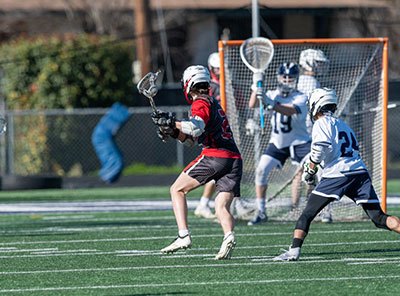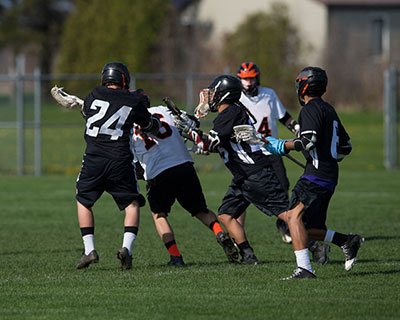As lacrosse players, it's our responsibility to know the fundamentals and abide by all rules of the game. Personal fouls are an especially important part of those rules and can have serious consequences if not handled properly.
In this post, we'll take a deeper dive into exactly what personal fouls are in lacrosse and how they impact safety for both players and teams.
More...
Take away key points:
If you're wondering what personal fouls in lacrosse are, if they can affect the game, and hurt other players, the guide below offers the best explanation about all factors to keep player safety a top priority.
What is a lacrosse personal foul?
A personal foul in lacrosse is a serious violation of lacrosse rules caused by illegal equipment use or illegal physical contact. Personal fouls are major infractions of the play; therefore, the punishments are stricter.
A personal foul will result in one to three minutes of a non-releasable penalty time for the offending player. The referee estimates whether the opposing team and the opposing player might suffer from severe injuries or whether the lacrosse equipment is illegal.

Must the offending player go to the penalty box to serve penalty time?
Once the referee punishes the offensive player for the violation, the player will get a one-to-three-minute non-releasable penalty. He must go to the penalty box. Due to the non-releasable penalty, he cannot come out of the penalty box until the penalty time runs out.
The player cannot leave the penalty box even if his team or the opponent scores a goal, and the opponent will have a man-up which is a huge advantage.
8 types of personal fouls in lacrosse
There are various personal fouls and penalties an offensive player might commit. The most common fouls include: unsportsmanlike conduct, illegal cross-check, illegal body-check, dangerous check in the sphere, spearing, tripping, slashing, and unnecessary roughness.
1. Unsportsmanlike conduct
Unsportsmanlike conduct in lacrosse occurs when a player uses inappropriate language toward the opponent or officials, threatens another player or officials, and commits a taunting foul.
Only the captain of one team (the same goes for the opponent) is allowed to speak to the referee, so the offensive players will be regulated if they speak aggressively and inappropriately to the official. Such behavior will result in a one-to-three-minute non-releasable penalty.
2. Illegal cross-check
Illegal cross-checking occurs when a player makes contact and strikes the opponent's stick (the shaft area) between the opponent's hands. Cross-check is legal in box lacrosse, but it is illegal in men's lacrosse and women's lacrosse, and the player will be serving the penalty time. Illegal cross-check results in a one-to-three-minute penalty in the penalty box.
3. Illegal body-checking
An illegal body check occurs when a player strikes his opponent from behind, in the sphere or legs. The illegal body check might also occur when a player shoves the opponent into the boards, or a body-check to an airborne player.
The body check is not allowed above the shoulders or below the waist. In addition, body-checking does not allow take-out checks (intended to injure the opponent).
4. Dangerous check in the sphere
A dangerous check in the sphere occurs when a defender uses his stick to sway in the opponent's head. The opponent's stick (the defender's lacrosse stick) strikes in the sphere and might hit the opponent's head.
The sphere is a seven-inch imaginary circle around each player's head. The stick does not have to make contact with the player's head to be deemed as dangerous.
5. Spearing
Spearing occurs when a player in the possession of the ball shows aggressive behavior toward his opponent. The offense will initiate contact with the head or block his opponent with the head. The penalties include one-to-three minutes in the box.
6. Tripping
Tripping occurs when a player intentionally impedes the movement of the opponent. The offensive player uses his stick or leg to trip the opponent and make them fall onto the ground.
7. Slashing
Slashing in lacrosse occurs when a player swings the stick toward the opponent and follows through in a low or high motion. The stick does not have to make contact with the opponent to count as a personal foul and a dangerous move.
8. Unnecessary roughness
Unnecessary roughness occurs when a player strikes his opponent with the body or stick and uses violent or excessive force. When the official notices that one player committed such a violation, the offender receives a penalty. In extreme cases, he might be ejected from the game, and the player cannot re-enter the game.
Officials especially do not tolerate roughness and aggressive behavior among younger players, as they might develop more aggressive behavior later in the play.
How many types of fouls are there in lacrosse?
There are two types of fouls in lacrosse: personal fouls and technical fouls.
What is not a personal foul in lacrosse?
Minor infractions that do not endanger the safety of the players are not personal fouls. These will result in a change of possession or releasable penalties.
The difference between personal and technical fouls

Technical fouls are minor infractions in the lacrosse game, and they are not as serious as personal fouls. Technical fouls are not safety-threatening.
Technical fouls usually result in thirty-seconds releasable lacrosse penalties, which means the player can leave the penalty box if his team or the opponent scores a goal. The opponent will also receive the possession of the ball.
6 types of personal fouls in lacrosse
A technical foul includes the following:
Warding
Warding occurs an offense when a player uses his hands or arms to push the opponent with the possession of the ball.
Holding
Holding occurs when a player impedes the free movement of the opponent and blocks him to reach the desired field area and place.
Offside
Offside occurs when there are too many offensive players or defensive players at the offensive side or defensive side on the lacrosse field at a particular time.
Crease violation
Crease violation occurs when an offensive player receives a penalty for crossing the crease area in front of the goal and goalie.
Only defense and the goalie can be inside the crease to protect the goal area.
Stalling
Stalling occurs when a team intentionally holds possession of the ball, with no intention of the offense. The main intention is to keep possession of the ball until the clock time runs off.
Interference
Interference occurs when a player interferes with the free movement of the opponent.
However, there are exceptions, such as when the opponent is in the possession of the ball, both players are within five yards of the loose ball, the attacked player is five yards within the loose ball, and the ball is flying.
Can you get ejected in lacrosse?
Yes, you can be ejected from lacrosse if you commit a severe personal foul, and endangers the safety of other participants, or if you use illegal lacrosse equipment.
When will an official eject a player from the game?
When a player has committed five personal fouls, he will be ejected from the game. However, if he violates the play standards by using any of the fouls mentioned above, the referees can eject such a player from the play, as he has jeopardized another player's safety standards.
The referee will stop play, assign the penalty, and the ejection might also be called upon if the acts were violent and deliberate.
Conclusion
Though personal fouls are a major part of the game, they often result in severe penalties that can hurt other players. The officials will immediately sanction such behavior, so it is important to be aware of the consequences of your actions on the field.
By understanding the rules and sticking to them, you can help keep lacrosse a safe and fun sport for everyone involved.

Freddy is the heart and soul of Lacrosse Runner. As a former athlete, Freddy is very passionate about Lacrosse. He keeps up with the sport’s changes and innovations and often tests the new equipment released by the leading manufacturers. Read more here
